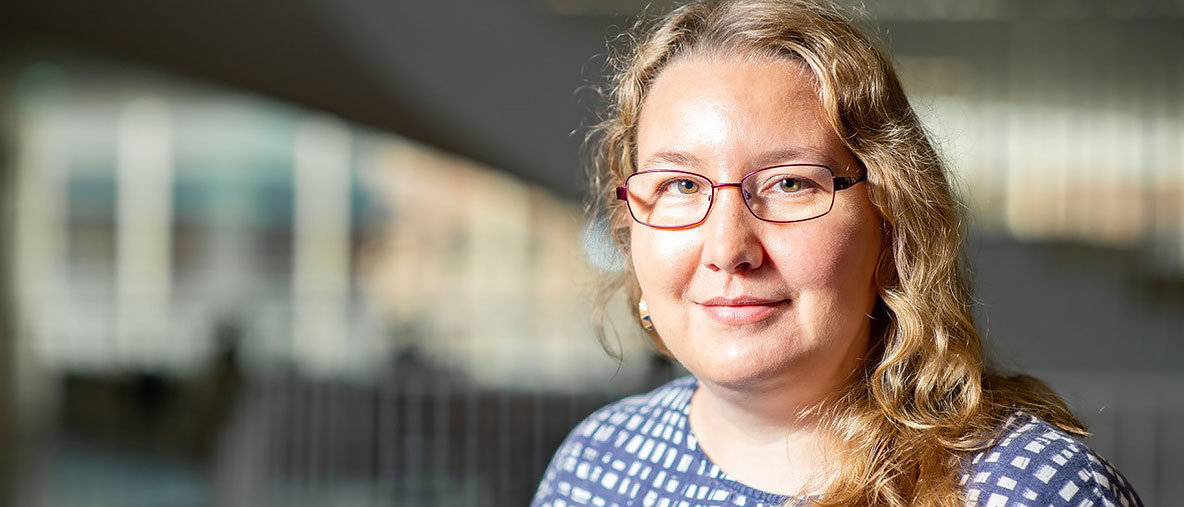


Photo: Lauri Laine
Kielipankki – The Language Bank of Finland is a service for researchers using language resources. Associate Professor in Ancient Near Eastern Studies at the University of Helsinki Saana Svärd tells us about how she makes use of the resources provided by Kielipankki.
I am Saana Svärd, Associate Professor in Ancient Near Eastern Studies and the director of the Academy of Finland funded Centre of Excellence in Ancient Near Eastern Empires, ANEE.
I’m originally an assyriologist, which means that I research different kinds of historical phenomena by using primary sources, e.g. the cuneiform texts from ancient Near East. In my research I have especially investigated what we can deduct about the status and roles of women in ancient Mesopotamia. This research is still on-going, but during the last four years I have concentrated on developing digital humanities approaches in my field. There exists hundreds of thousands of texts from the ancient Near East, and even though they are only partly available in digital form, there is a lot of digital research material available.
In the team I lead (ANEE team 1), we have conducted diverse research by combining the methods of language technology and assyriology. This type of language techonological research is new in the field of ancient Near Eastern studies and there is great potential for new discoveries. Our latest article is related to fear. How is fear depicted in the cuneiform texts? We created a semantic field from five verbs usually translated as “to fear,” as well as their derivatives. Among other things, the results showed that the vocabulary depicting fear in this ancient Semitic language (called Akkadian) is very diverge. Different lexemes for fear were used in different text genres and some of the fear-words were reserved for very specialized use. For example the word pirittu ”terror” is found almost exclusively in a certain type of prayer.
Kielipankki is essential for my research. Our digitized cuneiform sources originate from the Open Richly Annotated Cuneiform Corpus portal (ORACC), but they are also available in Kielipankki (oracc). By using the Korp-tool from Kielipankki, we have been able to efficiently investigate interesting words and their contexts. We are able to get interesting results about the semantic dimensions of an individual word or concept by using the language technological tools we have created, but the results always need to be investigated in their original context. Korp makes this possible in an easy way. Furthermore, Korp search results also provide links to the original texts in ORACC, so that the researchers can follow the links all the way to a photograph of cuneiform tablet, if needed.
Svärd, Saana, Tero Alstola, Heidi Jauhiainen, Aleksi Sahala, and Krister Lindén. Fear in Akkadian Texts. In S.-W. Hsu and J. Llop-Radua (eds.), The Expression of Emotions in Ancient Egypt and Mesopotamia. Culture and History of the Ancient Near East (CHANE), 116. Brill. Coming out in December 2020 (https://brill.com/view/title/57151)
Tero Alstola, Shana Zaia, Aleksi Sahala, Heidi Jauhiainen, Saana Svärd, Krister Linden. 2019. “Aššur and His Friends: A Statistical Analysis of Neo-Assyrian Texts” Journal of Cuneiform Studies 71, pp. 159-180. https://doi.org/10.1086/703859
Saana Svärd, Heidi Jauhiainen, Aleksi Sahala, Krister Lindén 2018 ”Semantic Domains in Akkadian Texts” in Vanessa Juloux, Amy Gansell, & Alessandro di Ludovico, (eds.) CyberResearch on the Ancient Near East and Neighboring Regions: Case Studies on Archaeological Data, Objects, Texts, and Digital Archiving. Digital Biblical Studies 2. Brill: Leiden, pp 224-256. DOI: https://doi.org/10.1163/9789004375086_009
The FIN-CLARIN consortium consists of a group of Finnish universities along with CSC – IT Center for Science and the Institute for the Languages of Finland (Kotus). FIN-CLARIN helps the researchers in Finland to use, to refine, to preserve and to share their language resources. The Language Bank of Finland is the collection of services that provides the language materials and tools for the research community.
All previously published Language Bank researcher interviews are stored in the Researcher of the Month archive.